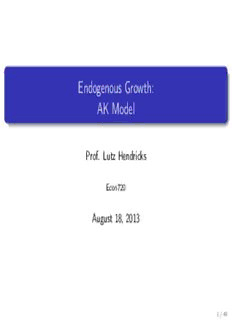
Endogenous Growth: AK Model - Lutz Hendricks PDF
Preview Endogenous Growth: AK Model - Lutz Hendricks
Endogenous Growth: AK Model Prof. Lutz Hendricks Econ720 October 28, 2022 1/43 Endogenous Growth Why do countries grow? ▶ A question with large welfare consequences. We need models where growth is endogenous. What drives growth in the data? How could one answer this question empirically? 2/43 Outline Necessary condition for sustained growth: ▶ MPK is bounded from below as K →∞ ▶ It does not matter what K is. The simplest endogenous growth model: ▶ a version of the standard growth model with linear technology ▶ K˙ =sY−δK =sAK−δK ▶ “AK model” More interesting models have R&D driven growth ▶ new varieties ▶ quality improvements All of these models have “AK” reduced forms. 3/43 Necessary Conditions for Sustained Growth ▶ How can growth be sustained without exogenous productivity growth? ▶ A necessary condition: constant returns to the reproducible factors. ▶ The production functions for inputs that can be accumulated must be linear in those inputs. ▶ Example: In the growth model, K would have to be produced with a technology that is linear in K ▶ This motivates a simple class of models in which 1. only K can be produced and 2. the production function is AK. ▶ This can be thought of as a reduced form for more complex models (we’ll see examples). 4/43 Solow AK model To see what is required for endogenous growth, consider the Solow model: k˙ =sf(k)−(n+δ)k (1) k could be anything that can be accumulated ▶ physical or human capital ▶ knowledge ▶ some combination of factors The saving rate s can be endogenous ▶ its value does not matter (mostly) ▶ because s is bounded 5/43 Solow AK model g(k)=sf(k)/k−(n+δ) (2) Positive long-run growth requires: ▶ As k→∞ it is the case that f(k)/k>n+δ (3) ▶ L’Hopital’s rule implies (if f′ has a limit): lim f(k)/k= limf′(k)≡A (4) k→∞ k→∞ Sustained growth therefore requires: limf′(k)≡A>n+δ (5) k→∞ 6/43 Necessary Conditions for Sustained Growth ▶ This argument is more general than the Solow model. ▶ It does not matter how s is determined. ▶ If lim f′(k) exists, the production function has asymptotic k→∞ constant returns to scale. f(k)→Ak+B (6) ▶ It is fine to have diminishing returns for finite k. 7/43 Example Diminishing returns with asymptotic AK: f(k)=Ak+Bkα (7) ▶ 0<α <1 ▶ f(k)/k→A as k→∞ 8/43 Example CES production function with high elasticity of substitution: (cid:104) (cid:105)1/θ F(K,L)= µKθ+(1−µ)Lθ (8) ▶ f(k)=(cid:2)µkθ+1−µ(cid:3)1/θ ▶ Elasticity of substitution: ε =(1−θ)−1. ▶ If θ >0 [ε >1], f(k)/k→µ1/θ (9) . 9/43 AK Solow Model ▶ In the Solow model, assume f(k)=Ak. ▶ Law of motion: g(k)=sA−n−δ (10) ▶ Changes in parameters alter the growth rate of k. ▶ The model does not have any transitional dynamics: k always grows at rate sA−n−δ. 10/43
Description: